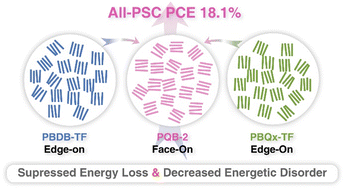Suppressing the energetic disorder of all-polymer solar cells enables over 18% efficiency†
Abstract
All-polymer solar cells (all-PSCs) usually have a complex blend morphology due to their higher probability of chain entanglement. Under these conditions, the larger energetic disorder is one of the most important factors that hinder the increase in power conversion efficiency (PCE). Here, to take full advantage of two highly efficient polymer donors, PBDB-TF and PBQx-TF, we design and synthesize three ternary copolymers, PQB-x (x represents 1–3). The results suggest that the optical absorption spectrum and molecular energy levels can be linearly tuned by adjusting the content of the acceptor component. Interestingly, ternary copolymerization changes the molecular orientation from the coexistence of face-on and edge-on to face-on only and accordingly suppresses the energetic disorder (44, 47, and 53 meV for PQB-2, PBQx-TF, and PBDB-TF). In cell devices based on a polymer acceptor PY-IT, PQB-2 shows decreased energy loss and thus an improved open-circuit voltage of 0.942 V. Transient absorption measurements reveal that the structural component ascribed to PBQx-TF provides an efficient charge transfer channel with PY-IT. As a result, the PQB-2:PY-IT-based device yields a maximum PCE of 18.1%, which is an outstanding value among all-PSCs. This study demonstrates that suppressing the energetic disorder by molecular design may be a feasible method for further improving the PCEs of all-PSCs.

- This article is part of the themed collection: Solar energy showcase


 Please wait while we load your content...
Please wait while we load your content...